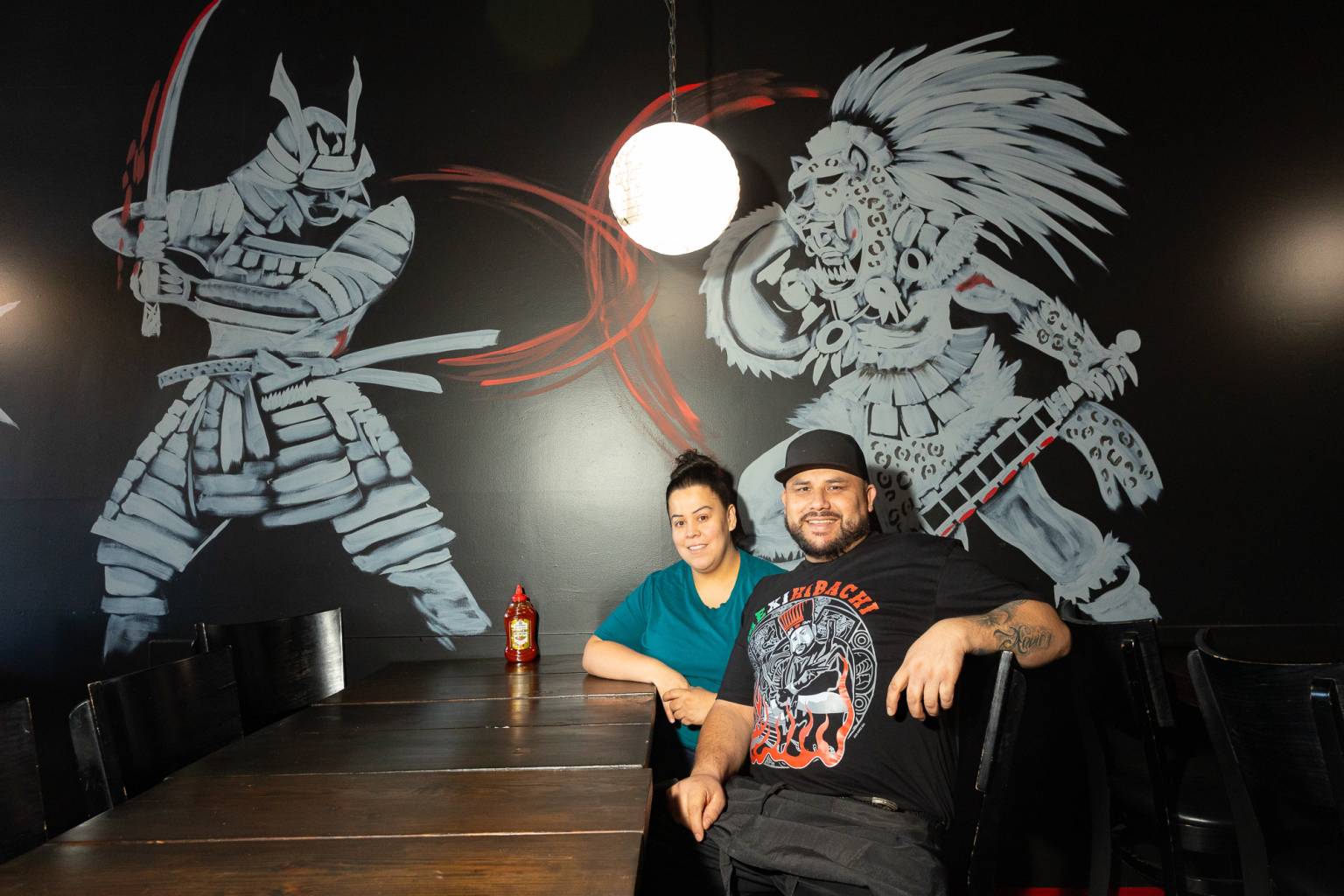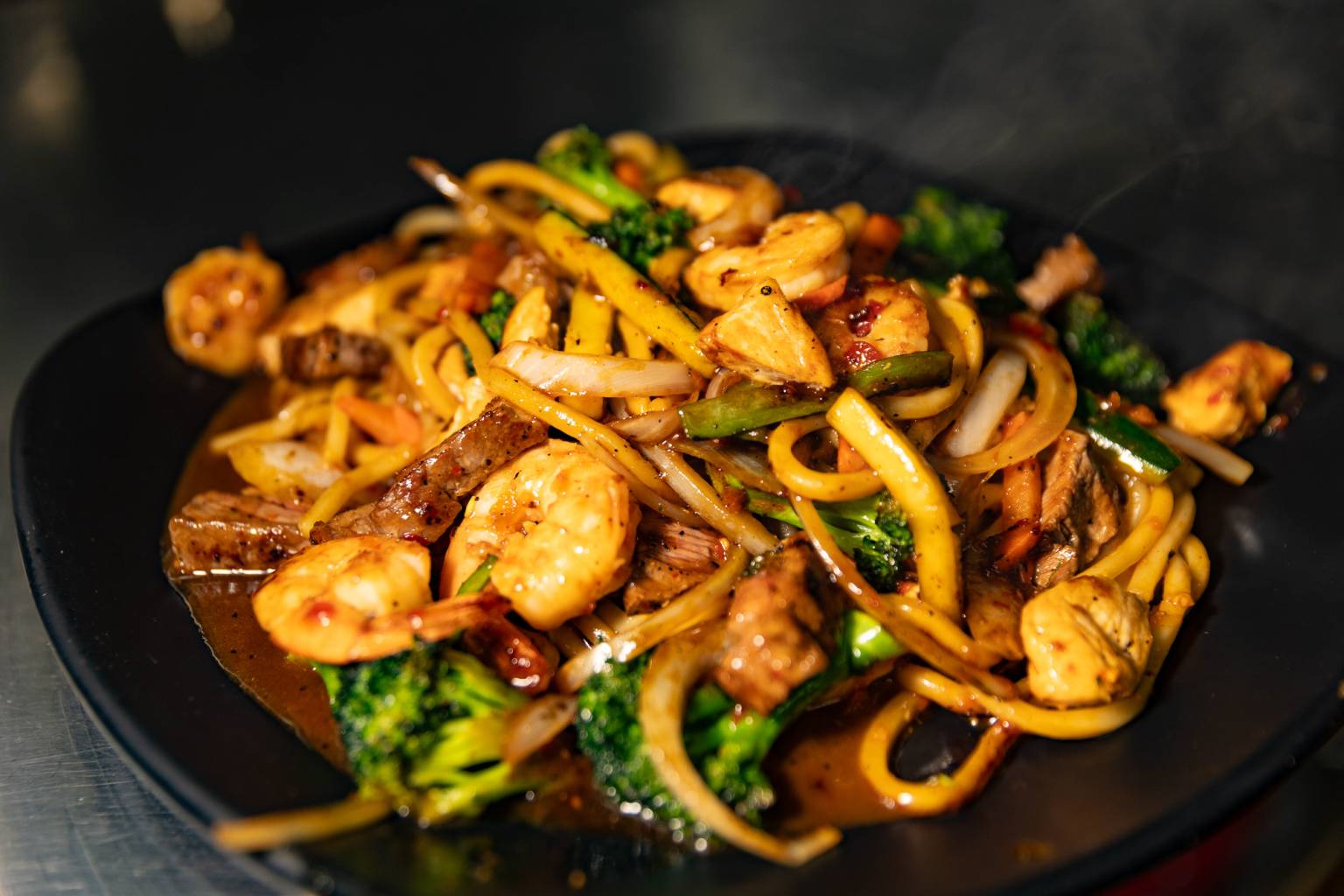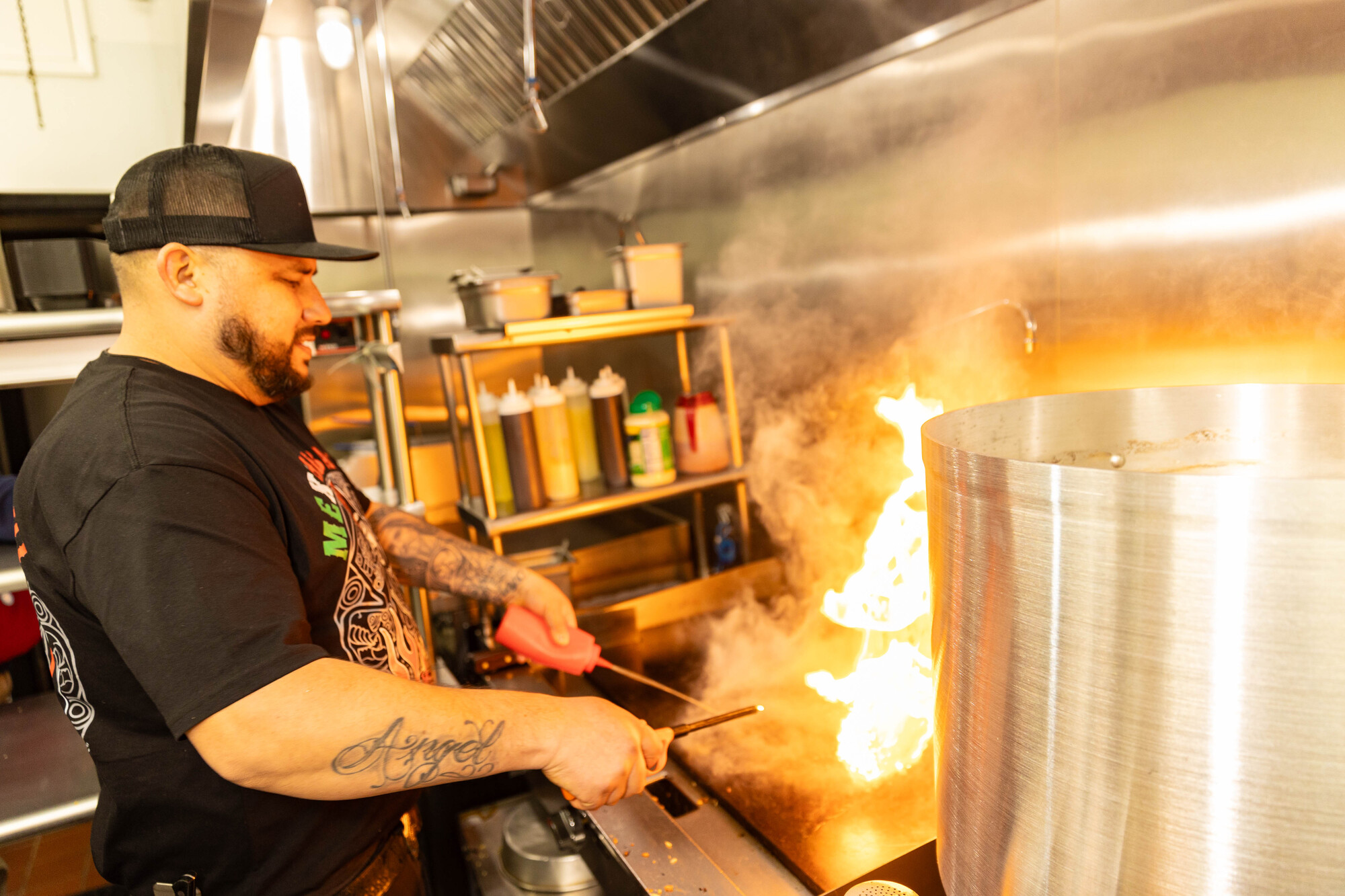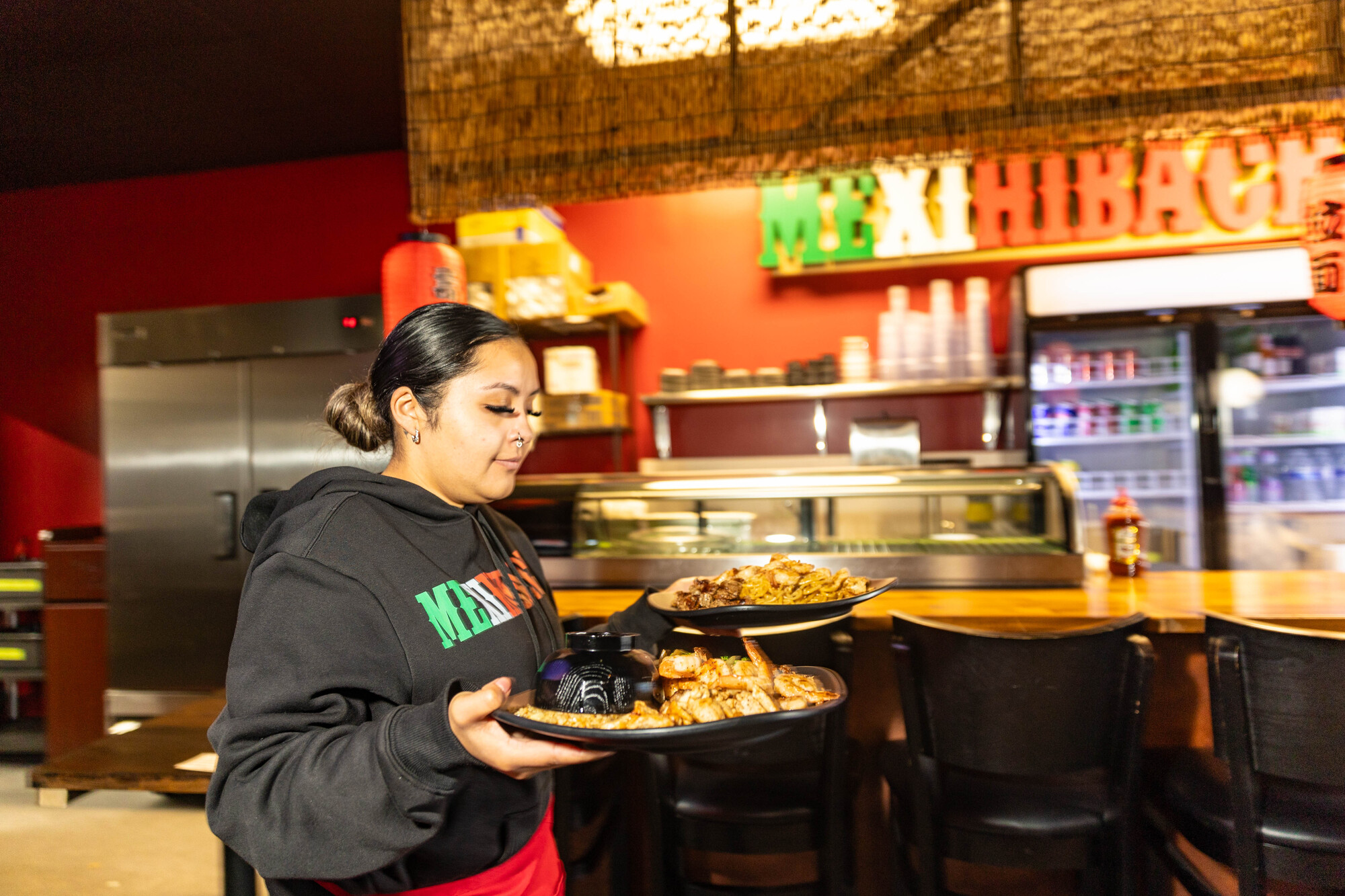





Posted on 02/15/2025 2:11:15 PM PST by nickcarraway
When you walk into MexiHibachi, a new Mexican-Japanese fusion restaurant in Pinole, the first thing you notice is the giant mural on the wall: a stylized image of a samurai — full armor, katana held upright — facing off against an Aztec warrior.
That’s just the first of many cultural collisions that grab the diner’s attention. There’s the endless loop of Karol G reggaeton music videos juxtaposed with traditional Japanese decor elements like red paper lanterns. There’s the name of the restaurant, “MexiHibachi,” painted in bold letters in the tricolor of the Mexican flag across the body of a flying dragon. And there are the smells — a potent mix of garlic butter, taco sauce and teriyaki that’s meant to get your mouth watering.
This is, after all, a restaurant that specializes in Benihana-style Japanese hibachi with a Mexican twist: big plates of steak and shrimp served over fried rice or garlic noodles, everything cooked on a flat-top grill — and also stuffed, sometimes, into a burrito or a quesadilla, and drizzled with the kind of creamy orange hot sauce you might find at your favorite taqueria.
That unique combination of flavors and cross-cultural influences has made MexiHibachi one of the hottest new restaurants in Contra Costa County since it opened in January.
The brainchild of chef Francisco Arce and his wife Silvia Cortes, the business started during the pandemic-spurred economic downturn of 2022, when Arce’s day job as a union painter had slowed to a standstill. With medical bills piling up for their young daughter, who needed eye surgery, the couple decided to supplement their income by starting a home-based catering operation. At first they mostly sold quesabirria, but at that point everyone was doing quesabirria. Meanwhile, Arce had picked up tens of thousands of followers on his TikTok cooking channel, where, among other recipes, he showed off the Benihana-style hibachi skills he’d learned working at a teppanyaki restaurant in Alameda. “Everyone was like, ‘Where can I get my hands on a plate?’” Cortes recalls.
So they decided to give it a shot. The first MexiHibachi pop-ups featured a portable flat-top grill that they set up in a 10-by-10-foot tent in front of their house in Richmond. Eventually, as word got out, they started booking big backyard quinceañera and anniversary parties, where Arce entertained guests by flipping shrimp directly into their mouths and casually lighting up the grill so the whole thing burst into flames.
At one of those pop-ups, MexiHibachi caught the attention of their current business partner, Juan Nuñez, a local entrepreneur and tattoo artist. He set Arce and Cortes up in their first brick-and-mortar kitchen space, a little takeout shop attached to Nuñez’s tattoo shop on San Pablo Avenue in Richmond. Business was brisk, and before long, they’d outgrown that kitchen as well. With Nuñez’s help, they found their current space, in a Pinole strip mall, last April and renovated the space themselves. (Nuñez, with his tattoo art background, did all the murals.)
On a surface level, MexiHibachi’s take on teppanyaki doesn’t look so different from what you might find at a regular old Benihana. Its staple dishes are the combo plates — your choice of proteins (steak, shrimp, chicken, salmon or scallops) served over a bed of garlicky, buttery fried rice; spicy udon noodles; or, my favorite, an excellent, extra-savory version of garlic noodles. But then in addition to your standard hibachi shop “yum yum” sauce (a creamy, slightly tangy aioli) and ginger soy sauce, customers also have the option to drench their meal in MexiHibachi’s fiery housemade diablo sauce (again, something akin to a taqueria orange sauce). Even more fusion-minded customers have the option to pack the whole meal inside the confines of a cheesy quesadilla or a burrito — with or without the addition of Hot Cheetos.
In the coming weeks, Arce plans to introduce more new dishes that play with the restaurant’s Mexican and Japanese influences. There will be a Baja-style fried fish taco, topped with both the red diablo sauce and the white yum yum sauce, for a subtle Japanese touch. They’ll also serve a version of spicy Mexican caldo de siete mares that has elements of an Asian seafood noodle soup.
Arce and Cortes didn’t invent the “Benihana-but-make-it-Mexican” food genre, but the trend seems to be fairly new, picking up steam in the early 2020s. A handful of other restaurants and food trucks with similar menus opened in the Bay Area in the past couple of years. There are even more of them in Southern California, where at least one popular chain — Mexihanas — has been around since 2020.
One might assume that the trend stems from some deep, abiding love that Mexican Americans have for Benihana and its offshoots, but Cortes says that hasn’t been her experience. While some of MexiHibachi’s younger Mexican American customers might have eaten at a Japanese teppanyaki spot like Benihana at some point, most of the older Latino customers have no idea what to make of the restaurant the first time they come. At first, she says, “we were being compared to Panda Express.”
“A lot of our clientele at the beginning were more African American than anything,” Cortes recalls. But as word about MexiHibachi spread, Latino customers started to familiarize themselves with the pleasures of a steak-and-shrimp combo plate and griddle-top garlic fried rice. “Now they know what hibachi is.”
The New York steak, chicken and shrimp spicy stir-fry udon plate. (Gina Castro/KQED) Given that most Mexican American diners don’t have a long history with Japanese teppanyaki, the origin of the Mexican hibachi trend is probably even more obvious and mundane: As Nuñez notes, if you walk into any Benihana-style restaurant in the Bay Area these days, the vast majority of the chefs doing the fancy tricks on the grill will be Latino. (Arce himself learned his craft at one of those spots, after all.) It only makes sense, then, that some of those cooks would eventually open their own hibachi businesses and put their cultural stamp on the cuisine. It’s the same reason we’ve seen an infusion of ambitious Mexican-owned sushi restaurants and red-sauce pasta joints.
Of course even more than the food itself, Benihanas are famous for their bag of tricks — the juggling of spatulas, the shrimp tails flipped into the chef’s hat, the eggs that magically multiply underneath a bowl. And, as it turns out, MexiHibachi’s kitchen crew all trained in this dinner-and-a-show approach to teppanyaki; they’re fully conversant in the language of flaming onion volcanos. Arce has been honing his repertoire of crowd-pleasing stunts for years — one of his most popular moves, he says, is when he makes the steaks dance on the plancha to the tune of “I Like to Move It.”
For now, Cortes says, only customers who book MexiHibachi for private catering events will get a whole show with their meal. Their current space in Pinole isn’t big enough for the chefs to do tableside grilling, and the kitchen is set up, conventionally, in the back. A big chunk of the restaurant’s business is just takeout orders.
“But,” Cortes says, “it’s definitely our goal and dream to open a fancy restaurant like that, like a Benihana, in the future.” There’s no precedent for that kind of grand, showy Mexican fusion teppanyaki restaurant in the Bay Area, and even L.A.’s more established Mexican hibachi scene mostly consists of food trucks and small takeout shops. But Arce and Cortes don’t think the idea is all that far-fetched — not when their business has already grown so much in the span of just a couple of years.
“I definitely see it happening,” she says.
MexiHibachi is open Wednesday to Thursday noon–9 p.m., Friday to Saturday noon–10 p.m. and Sunday noon–8 p.m. at 1578 Fitzgerald Dr. in Pinole.






Tip (width thing) for next time:
<img src="https://someplace.com/image_thing.jpg" width="700">
That looks tasty.
You could land a helicopter on those eyelashes.

Looks mighty tasty.
Looks like cultural appropriation to me
Looks like fajitas.
I think one of these may be opening by us. I saw a sign the other day that read Texas-Mex Hibachi.
Fusion can be a good thing (and not just in generating electricity): in San Antonio there’s a place that matches BBQ with curry.
That’s the truth.
People still gotta eat, and L.A.is burning where rich folks didn’t clear brush up their gated canyon communities. The urban concrete jungle of the L.A. Basin is not burning where most of the working and normal folks live. For then life goes on with the epic biblical level traffic to boot. If there is one thing L.A. Does well it’s food they have nearly as much different cultures and foods that go with them as Houston being number one with 170+ languages and groups present then Queen’s NYC L.A. Is third down the list.
There are lots of Japanese and Chinese in Mexico especially Baja and Mexico City. Mexico was a popular immigration destination after WWII for Japanese and earlier during the 1800s lots of Chinese came to build railroads and ports. I have friends who are nearly 100% Japanese they look Japanese but speak fluent Mexico City Spanish and not ten words of Japanese like most third generation immigrants they speak what their grew up in home country speak they ARE Mexicans having been born there , have citizenship and speak the language with all the cultural idioms that native speakers have. Just because their great grand parents came from Japan does not nmake them Japanese any more than a third generation American of Irish or British great grand parents are Irish or British. Same same.
Big D has fusion in both directions.
The Japanese have been in Mexico for well over a century. My pretty good friend from Mexico City is Japanese 75% by DNA but doesn’t speak Japanese he speaks Mexico City Spanish and their chopped up version of English. We call it spanglish. He considers and identifies as Mexican he only holds a Mexican passport and a US green card he is ineligible for Japanese citizenship at that.
Thanks.
Disclaimer: Opinions posted on Free Republic are those of the individual posters and do not necessarily represent the opinion of Free Republic or its management. All materials posted herein are protected by copyright law and the exemption for fair use of copyrighted works.